Hunting, Steeple-Chasing, Racing Scenes.
Illustrated by Ben Herring
Autor: Fitt, J. Nevill, Erscheinungsjahr: 1869
Themenbereiche
Inhaltsverzeichnis
- Kapitel 01 - Tattersall’s.
- Kapitel 02 - The Duke of Beaufort, M.F.H.
- Kapitel 03 - The Meet.
- Kapitel 04 - Breaking Cover.
- Kapitel 05 - Full Cry.
- Kapitel 06 - Crossing the Line.
- Kapitel 07 - The Death.
- Kapitel 08 - Lord Poulett.
- Kapitel 09 - The First Fence.
- Kapitel 10 - Come To Grief.
- Kapitel 11 - Winning Easily.
- Kapitel 12 - Sir Joseph Hawley.
- Kapitel 13 - Stockwell And Blink Bonny.
- Kapitel 14 - Going To The Post.
- Kapitel 15 - Bringing In The Winner.
- Kapitel 16 - Epsom Downs On The Derby Day.
Kapitel 01 - Tattersall's
In presenting our little work to the public, it became necessary to choose some frontispiece that might, as it were, afford a theme on which to found our introductory notice; for a preface, like the preparatory canter to the race-horse, serves to give the aspiring author confidence ere he is actually called on to face the reader — we had almost written starter. This selection was a matter of no small difficulty; for though scenes representing either one diversion or another are easily pitched upon, we desired to give something that should embody the idea of the three great English sports, Hunting, Steeple-Chasing, and Racing. In one spot, and one only, may they all be said to centre, and that spot is Tattersall’s. Hero the blood sire and brood mare are almost weekly offered for public competition. Here the yearling, though certainly not showing to such advantage as in the green pastures of Hampton Court, Middle Park, East Acton, Knavesmire, or Doncaster, is yet to be seen. And in some sort the latter resorts of pleasure and business to so many connected with the race-horse are mere extensions of the spot we have now under consideration — are Tattersall’s „out of Town,“ so to speak — since the same influence presides over both. Here the best hunters in the world are yearly offered for public competition; and within the last few years it has been our lot to see exemplified the price that men who mean business will pay for blood, bone, and weight-carrying power. Here we have seen a young and green horse of promise realise the unheard-of sum of £450 for his good looks alone; and this not, be it remembered, with the idea of winning large stakes through his means, but simply to enable one who will not be denied to hold his own in the first flight over a stiff country. Here also are at various times to be seen the steeple-chasers of the day — good, bad, and indifferent, the two latter classes unfortunately predominating, whom their owners, either from necessity or prudence, are anxious to be quit of.
Neither must hounds be forgotten: though latterly it has become the custom to dispose of them at their respective kennels, still notices are not by any means wanting in which Tattersall’s has been selected as the vènue for their transfer of ownership. Here meet the sporting men of all classes, the owner of horses, the gentleman jockey and the trainer, the M.F.H. and the „leg,“ the betting man and the „nobbler.“ Here, during the spring and summer months, the student of character can easily detect the huntsman and whip secking situations; the stud-groom who has brought his late master’s stud in blooming condition to the hammer, and is himself likewise on the look-out for a situation for the ensuing season; while, in juxtaposition to these, may be seen the loafer and cad of every degree, anxious for a job that may turn him in a shilling, or, should that not forthcoming, athirst for the humble „two pennorth.“
No scene, then, could be so well suited for our fontispiece as the one where sporting characters of every type and variety mingle; and as the artist has presented to the eye a truthful sketch of Tattersall’s as it is, a slight resumé of its origin and foundation, from our pen, may not be altogether out of place in the introduction to a work descriptive of those sports which are so intimately connected with the time-honoured rendezvous. From authentic records we have been able to glean the following facts concerning the „Corner,“ as it was wont to be termed, and the family whose fortunes have been so closely identified with its history and records : —
About the year 1760 we find Mr. Tattersall opened the Old Corner, and by his straightforward conduct and upright dealings soon gained the esteem of all with whom he was brought in contact. That he had a good knowledge of the horse and his requirements may be inferred from his purchase of the celebrated Highflyer, who realised such a sum for his services at the stud, that the estate called Highflyer Hall was purchased therefrom. In the early part of the present century a violent discussion raged amongst sporting writers as to whether this horse had ever been beaten. Though we are inclined to the belief that, like many of those early turf worthies who had few horses to contend against them, and no handicaps to give the bad ones a chance, he was always victorious, no satisfactory proof either way is forthcoming. It matters but little, as his stud fame is a sufficient „In Memoriam“ for the scion of Herod; and when Old Tat gave his celebrated „Hammer and Highflyer“ toasts at the Annual Jockey Festival, doubtless it was more of the stud farm than the starting-post that he was thinking. In 1776 he signed a lease of the place for ninety-nine years with Lord Grosvenor; but the term had not run its length when his successors sought a fresh resting-place, and the new buildings were erected at Knightsbridge. How many delightful memories vanished with the old spot, it boots not now to inquire. How the pleasant afternoons on the lawn were missed by the old school, and how many figures, long since passed from the rooms, must have come more dimly on the imagination when, the haunt of nearly a century was vacated, will but little interest the modern school of turf men. The old „Corner,“ like old customs, has passed away, and now, instead of a race or two per diem at Newmarket, and but a few betting men with the entric to the rooms, we find racing enough to satisfy the veriest glutton, and bookmakers outnumbering backers. The numbers of subscribers increased so much that a new room was built even at the old place; and when, in 1865, the new edifice arose, the temple of fortune with all its adjuncts was not forgotten. But it is not so much with the betting-room, sacred to chosen members of the turf, we would now deal, as the broader sphere of the yard, where, despite the immense quantity of stabling provided, weeks’ — even at times months’ — notice is required to procure a stall. Here, on every Monday and Thursday during the season, save the Thursdays in the Epsom and Ascot weeks, may be seen horses of all descriptions — from the slashing hunter worth five hundred guineas, to the diminutive „sheltie,“ who, with a character, will fetch a goodly sum to train our future race of cross-country heroes. Here, all excitement, with tossing mane and fiery eye, the blood sire comes proudly up to the box, and, ere Mr. Tattersall’s warning voice can be heard, clears the ring for himself of all interlopers. Here the high-priced „joungster,“ having been put through the mill and found wanting, is often at two years old sold at about a shilling in the pound of his former price — as a yearling — for „a cabber.“ But perhaps the most truly representative day we could select is „Milward Monday,“ when men of all classes and denominations come together to witness the disposal of the draft of those hackneys for which Mr. Milward has justly become so famous. Rare prices they fetch, too, and but little call has Mr. Tattersall to point out their merits, as with grand action they step down the ride, and a nod responds to nearly every footfall. Men of business, men of pleasure, turf men, hunting men, and churchmen, all like a good hackney, and all strain a point to be there when these little horses are put up. Besides the fine range of stabling all round the yard, there is an outer square of boxes for yearlings, stallions, and brood mares; while over the inner range of stables is a gallery for carriages, harness, &c., which, on any grand day, is thronged to excess in all those parts near the rostrum. The same cupola and the same fox that adorned the old yard are still to be seen in the centre of the present one; and long may they afford a rallying point for those who come to hear the tap of the Tattersall hammer. How the present members of the firm were entertained on the occasion of their removing to their new quarters is on record, and we need only refer to the event to prove that we have made no mistake in taking Tattersall’s for our opening remarks on Hunting, Steeple-Chasing, and Racing.
In presenting our little work to the public, it became necessary to choose some frontispiece that might, as it were, afford a theme on which to found our introductory notice; for a preface, like the preparatory canter to the race-horse, serves to give the aspiring author confidence ere he is actually called on to face the reader — we had almost written starter. This selection was a matter of no small difficulty; for though scenes representing either one diversion or another are easily pitched upon, we desired to give something that should embody the idea of the three great English sports, Hunting, Steeple-Chasing, and Racing. In one spot, and one only, may they all be said to centre, and that spot is Tattersall’s. Hero the blood sire and brood mare are almost weekly offered for public competition. Here the yearling, though certainly not showing to such advantage as in the green pastures of Hampton Court, Middle Park, East Acton, Knavesmire, or Doncaster, is yet to be seen. And in some sort the latter resorts of pleasure and business to so many connected with the race-horse are mere extensions of the spot we have now under consideration — are Tattersall’s „out of Town,“ so to speak — since the same influence presides over both. Here the best hunters in the world are yearly offered for public competition; and within the last few years it has been our lot to see exemplified the price that men who mean business will pay for blood, bone, and weight-carrying power. Here we have seen a young and green horse of promise realise the unheard-of sum of £450 for his good looks alone; and this not, be it remembered, with the idea of winning large stakes through his means, but simply to enable one who will not be denied to hold his own in the first flight over a stiff country. Here also are at various times to be seen the steeple-chasers of the day — good, bad, and indifferent, the two latter classes unfortunately predominating, whom their owners, either from necessity or prudence, are anxious to be quit of.
Neither must hounds be forgotten: though latterly it has become the custom to dispose of them at their respective kennels, still notices are not by any means wanting in which Tattersall’s has been selected as the vènue for their transfer of ownership. Here meet the sporting men of all classes, the owner of horses, the gentleman jockey and the trainer, the M.F.H. and the „leg,“ the betting man and the „nobbler.“ Here, during the spring and summer months, the student of character can easily detect the huntsman and whip secking situations; the stud-groom who has brought his late master’s stud in blooming condition to the hammer, and is himself likewise on the look-out for a situation for the ensuing season; while, in juxtaposition to these, may be seen the loafer and cad of every degree, anxious for a job that may turn him in a shilling, or, should that not forthcoming, athirst for the humble „two pennorth.“
No scene, then, could be so well suited for our fontispiece as the one where sporting characters of every type and variety mingle; and as the artist has presented to the eye a truthful sketch of Tattersall’s as it is, a slight resumé of its origin and foundation, from our pen, may not be altogether out of place in the introduction to a work descriptive of those sports which are so intimately connected with the time-honoured rendezvous. From authentic records we have been able to glean the following facts concerning the „Corner,“ as it was wont to be termed, and the family whose fortunes have been so closely identified with its history and records : —
About the year 1760 we find Mr. Tattersall opened the Old Corner, and by his straightforward conduct and upright dealings soon gained the esteem of all with whom he was brought in contact. That he had a good knowledge of the horse and his requirements may be inferred from his purchase of the celebrated Highflyer, who realised such a sum for his services at the stud, that the estate called Highflyer Hall was purchased therefrom. In the early part of the present century a violent discussion raged amongst sporting writers as to whether this horse had ever been beaten. Though we are inclined to the belief that, like many of those early turf worthies who had few horses to contend against them, and no handicaps to give the bad ones a chance, he was always victorious, no satisfactory proof either way is forthcoming. It matters but little, as his stud fame is a sufficient „In Memoriam“ for the scion of Herod; and when Old Tat gave his celebrated „Hammer and Highflyer“ toasts at the Annual Jockey Festival, doubtless it was more of the stud farm than the starting-post that he was thinking. In 1776 he signed a lease of the place for ninety-nine years with Lord Grosvenor; but the term had not run its length when his successors sought a fresh resting-place, and the new buildings were erected at Knightsbridge. How many delightful memories vanished with the old spot, it boots not now to inquire. How the pleasant afternoons on the lawn were missed by the old school, and how many figures, long since passed from the rooms, must have come more dimly on the imagination when, the haunt of nearly a century was vacated, will but little interest the modern school of turf men. The old „Corner,“ like old customs, has passed away, and now, instead of a race or two per diem at Newmarket, and but a few betting men with the entric to the rooms, we find racing enough to satisfy the veriest glutton, and bookmakers outnumbering backers. The numbers of subscribers increased so much that a new room was built even at the old place; and when, in 1865, the new edifice arose, the temple of fortune with all its adjuncts was not forgotten. But it is not so much with the betting-room, sacred to chosen members of the turf, we would now deal, as the broader sphere of the yard, where, despite the immense quantity of stabling provided, weeks’ — even at times months’ — notice is required to procure a stall. Here, on every Monday and Thursday during the season, save the Thursdays in the Epsom and Ascot weeks, may be seen horses of all descriptions — from the slashing hunter worth five hundred guineas, to the diminutive „sheltie,“ who, with a character, will fetch a goodly sum to train our future race of cross-country heroes. Here, all excitement, with tossing mane and fiery eye, the blood sire comes proudly up to the box, and, ere Mr. Tattersall’s warning voice can be heard, clears the ring for himself of all interlopers. Here the high-priced „joungster,“ having been put through the mill and found wanting, is often at two years old sold at about a shilling in the pound of his former price — as a yearling — for „a cabber.“ But perhaps the most truly representative day we could select is „Milward Monday,“ when men of all classes and denominations come together to witness the disposal of the draft of those hackneys for which Mr. Milward has justly become so famous. Rare prices they fetch, too, and but little call has Mr. Tattersall to point out their merits, as with grand action they step down the ride, and a nod responds to nearly every footfall. Men of business, men of pleasure, turf men, hunting men, and churchmen, all like a good hackney, and all strain a point to be there when these little horses are put up. Besides the fine range of stabling all round the yard, there is an outer square of boxes for yearlings, stallions, and brood mares; while over the inner range of stables is a gallery for carriages, harness, &c., which, on any grand day, is thronged to excess in all those parts near the rostrum. The same cupola and the same fox that adorned the old yard are still to be seen in the centre of the present one; and long may they afford a rallying point for those who come to hear the tap of the Tattersall hammer. How the present members of the firm were entertained on the occasion of their removing to their new quarters is on record, and we need only refer to the event to prove that we have made no mistake in taking Tattersall’s for our opening remarks on Hunting, Steeple-Chasing, and Racing.
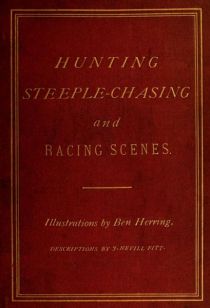
Hunting, Steeple-Chasing, Racing Scenes. - Cover 1869
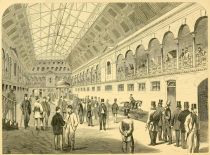
Tattersall’s.
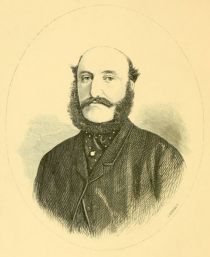
The Duke of Beaufort, M.F.H.
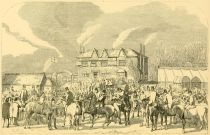
The Meet.
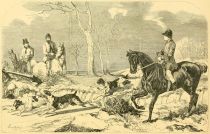
Breaking Cover.
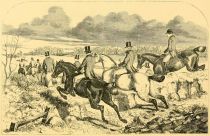
Full Cry.
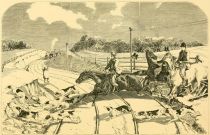
Crossing the Line.
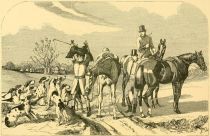
The Death.
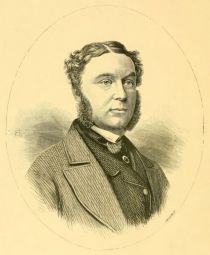
Lord Poulett.
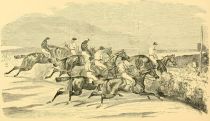
The First Fence.
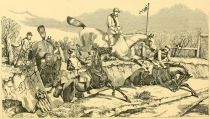
Come To Grief.
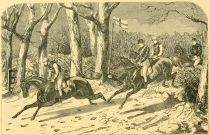
Winning Easily.
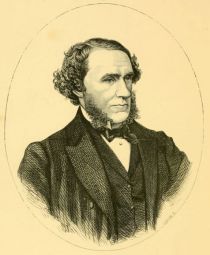
Sir Joseph Hawley.
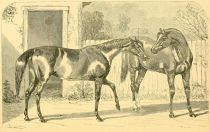
Stockwell And Blink Bonny.
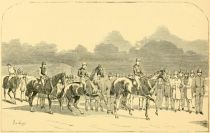
Going To The Post.
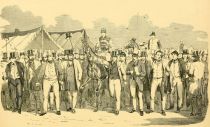
Bringing In The Winner.

Epsom Downs On The Derby Day.